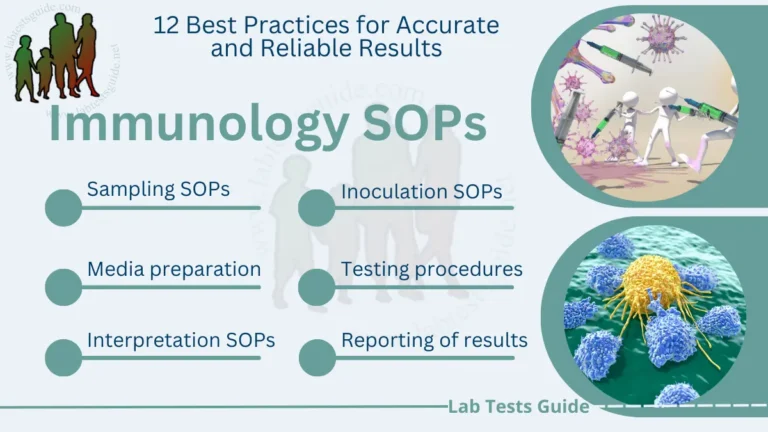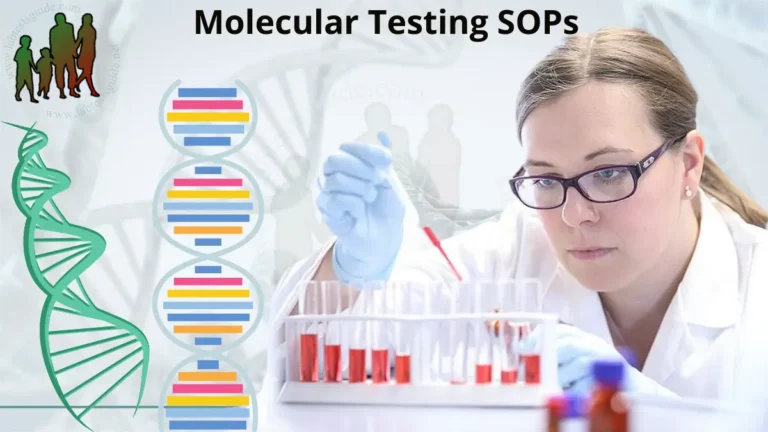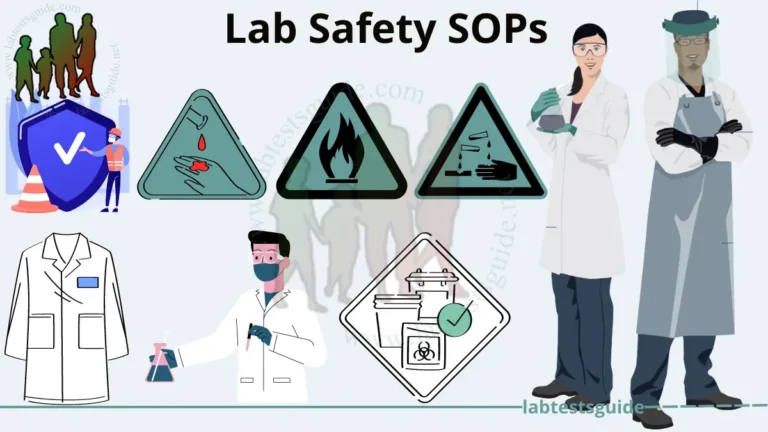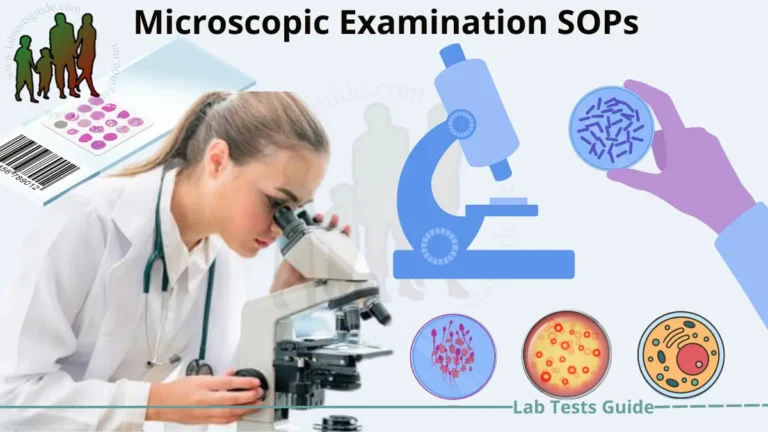Phlebotomy SOPs in a pathology laboratory are essential to ensure the safety of the patient and the phlebotomist, maintain the integrity of the blood sample, and provide accurate test results.
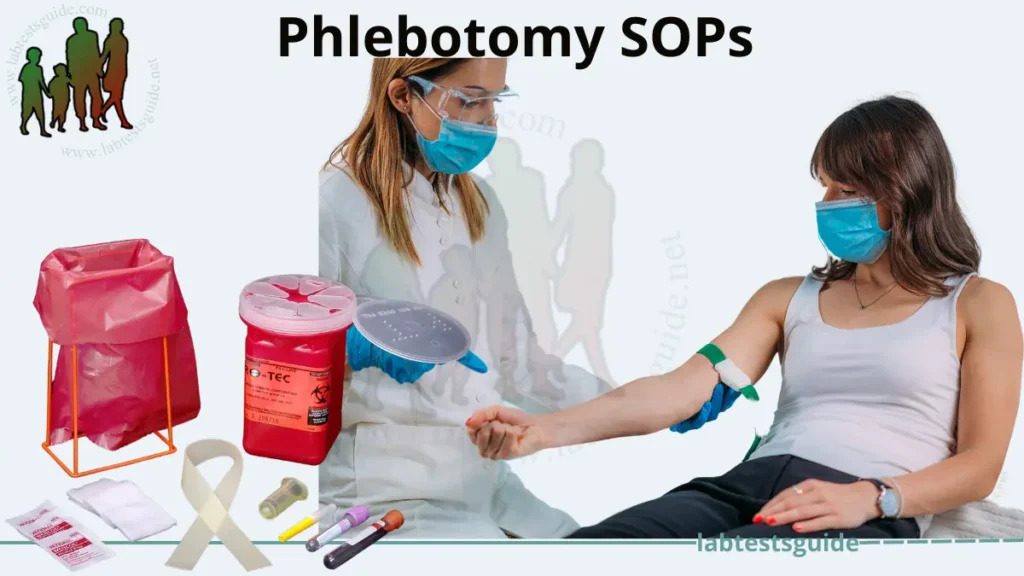
Best Practices for Developing Phlebotomy SOPs
Here are some general guidelines for Phlebotomy SOPs in a pathology laboratory:
- Identify the patient: Confirm the patient’s identity by asking for their name, date of birth, and other identifying information such as hospital number, unique patient identifier, or social security number.
- Explain the procedure: Explain the phlebotomy procedure to the patient, including the purpose of the blood draw, the type of test to be performed, and any potential risks or discomfort associated with the procedure.
- Obtain informed consent: Obtain informed consent from the patient, if necessary, and document it in the patient’s medical record.
- Prepare the equipment: Prepare the phlebotomy equipment, including needles, syringes, and collection tubes, according to the laboratory’s protocols.
- Perform hand hygiene: Perform hand hygiene using soap and water or an alcohol-based hand rub before putting on gloves.
- Use personal protective equipment (PPE): Use appropriate PPE, such as gloves, gowns, and face shields or masks, to protect against potential exposure to blood or bodily fluids.
- Select the appropriate site: Select the appropriate site for venipuncture, considering the patient’s age, medical condition, and previous venipuncture history.
- Clean the site: Clean the selected site with an antiseptic solution and allow it to dry before performing venipuncture.
- Perform venipuncture: Perform venipuncture using the appropriate technique, such as the evacuated tube system or the syringe method, and follow the laboratory’s protocols for blood collection.
- Label the specimen: Label the specimen collection tubes with the patient’s identification information, date, and time of collection, and other required information according to the laboratory’s protocols.
- Apply pressure: Apply pressure to the venipuncture site after withdrawing the needle to prevent bleeding and minimize the risk of hematoma formation.
- Dispose of sharps: Dispose of needles, syringes, and other sharps in appropriate sharps containers, following OSHA guidelines.
- Document the procedure: Document the phlebotomy procedure, including the patient’s identification information, the date and time of collection, the type of test requested, and any relevant information such as the size of the needle used, in the patient’s medical record or laboratory information system.
- Perform post-procedure care: Provide post-procedure care to the patient, including instructions for caring for the venipuncture site and any potential complications, such as infection or hematoma.
- Perform quality control checks: Perform quality control checks on the collected specimens, such as verifying that the labeling information matches the patient’s identification information and ensuring that the specimens are properly stored and transported to the laboratory.
Following these SOPs for phlebotomy in a pathology laboratory can help ensure the safety and comfort of the patient, protect the phlebotomist and laboratory staff from exposure to bloodborne pathogens, and provide accurate test results for diagnosis and treatment.
Identify the patient:
Identifying the patient is the first step in the Phlebotomy SOPs. The phlebotomist should confirm the patient’s identity by asking for their name, date of birth, and other identifying information such as hospital number, unique patient identifier, or social security number. This is important to ensure that the blood sample is collected from the correct patient and to avoid errors or mix-ups in the laboratory.
Explain the procedure:
The phlebotomy procedure involves the collection of a blood sample from a patient for diagnostic or therapeutic purposes. The phlebotomist will explain the procedure to the patient, including the purpose of the blood draw, the type of test to be performed, and any potential risks or discomfort associated with the procedure. The phlebotomist will also obtain the patient’s consent, if necessary, before proceeding with the blood draw. The procedure typically involves selecting an appropriate site for venipuncture, cleaning the site with an antiseptic solution, performing venipuncture using a needle and collection tube, labeling the specimen collection tubes with the patient’s identification information, and documenting the procedure in the patient’s medical record or laboratory information system. After the blood draw, the phlebotomist will provide post-procedure care to the patient, including instructions for caring for the venipuncture site and any potential complications, such as infection or hematoma. Following proper phlebotomy procedures is important to ensure the safety of the patient and the accuracy of test results.
Obtain informed consent:
Obtaining informed consent is an important step in the Phlebotomy SOPs. The phlebotomist should explain the procedure to the patient, including the purpose of the blood draw, the type of test to be performed, and any potential risks or discomfort associated with the procedure. The phlebotomist should also obtain the patient’s consent, if necessary, before proceeding with the blood draw. Informed consent involves providing the patient with information about the procedure, including its benefits and risks, and allowing the patient to make an informed decision about whether or not to proceed with the procedure. In some cases, such as when the patient is unable to provide consent, consent may need to be obtained from a legal representative or family member. The phlebotomist should document the informed consent process in the patient’s medical record. Obtaining informed consent is important to ensure that the patient understands the procedure and has given permission for the blood draw to be performed.
Prepare the Equipment:
Preparing the equipment is an important step in the Phlebotomy SOPs to ensure that the blood draw is performed safely and accurately. The phlebotomist should prepare the phlebotomy equipment, including needles, syringes, and collection tubes, according to the laboratory’s protocols. This may include selecting the appropriate size and type of needle, selecting the appropriate collection tubes for the tests ordered, and ensuring that all equipment is clean and in good working order. The phlebotomist should also ensure that all necessary supplies, such as gloves, gauze, and antiseptic solution, are readily available. Proper equipment preparation is important to ensure that the blood draw is performed safely and accurately, and to prevent the risk of contamination or infection.
Perform Hand Hygiene:
Performing hand hygiene is a critical step in the Phlebotomy SOPs to prevent the spread of infection and ensure patient safety. The phlebotomist should perform hand hygiene before and after performing the blood draw, as well as any time there is a risk of exposure to bodily fluids or contaminated surfaces. Hand hygiene can be performed using either soap and water or alcohol-based hand sanitizer, depending on the situation and the laboratory’s protocols. To perform hand hygiene with soap and water, the phlebotomist should wet their hands, apply soap, and rub their hands together for at least 20 seconds, making sure to clean all surfaces of the hands, including the fingers, nails, and wrists. The hands should then be rinsed thoroughly and dried with a clean towel or air dryer. To perform hand hygiene with alcohol-based hand sanitizer, the phlebotomist should apply a sufficient amount of sanitizer to their hands and rub their hands together until the sanitizer has dried. Proper hand hygiene is important to prevent the spread of infection and to ensure the safety of the patient and the phlebotomist.
Use personal protective equipment (PPE):
Using personal protective equipment (PPE) is an important step in the Phlebotomy SOPs to ensure the safety of the phlebotomist and the patient. The type of PPE required may vary depending on the laboratory’s protocols and the specific risks associated with the blood draw, but generally includes gloves, gowns, masks, and eye protection. The phlebotomist should don PPE before beginning the blood draw and should remove and dispose of PPE properly after completing the procedure. Gloves should be worn during the blood draw to prevent exposure to blood or bodily fluids and should be changed if they become torn or contaminated. Gowns, masks, and eye protection may be necessary depending on the specific risks associated with the blood draw. Proper use of PPE is important to prevent the spread of infection and to ensure the safety of the phlebotomist and the patient.
Select the appropriate site:
Selecting the appropriate site for venipuncture is an important step in the Phlebotomy SOPs to ensure the safety of the patient and the accuracy of the blood draw. The phlebotomist should select a site that is accessible, visible, and free from visible signs of infection, scarring, or other abnormalities. The most common sites for venipuncture are the antecubital fossa (the crease of the elbow), the back of the hand, and the wrist. The phlebotomist should avoid using sites that are swollen, bruised, or injured, as well as sites that are near an IV or other medical device. The phlebotomist should also consider the patient’s comfort and any other factors that may affect the success of the blood draw, such as the patient’s age or medical history. Proper site selection is important to ensure the safety of the patient and the accuracy of the blood draw.
Clean the site:
Cleaning the site is an important step in the Phlebotomy SOPs to prevent infection and ensure the accuracy of the blood draw. The phlebotomist should clean the site with an antiseptic solution, such as alcohol or iodine, before performing the venipuncture. To clean the site, the phlebotomist should follow these steps:
- Put on gloves.
- Select the appropriate antiseptic solution and ensure it is within reach.
- Ask the patient to extend their arm and identify the site for venipuncture.
- Apply the antiseptic solution to the site and allow it to dry completely, following the manufacturer’s instructions for use.
- Do not blow on or fan the site to hasten drying as it may introduce bacteria.
The phlebotomist should be careful not to touch the cleaned site after the antiseptic has been applied, to avoid introducing new bacteria or contaminants to the site. Proper cleaning of the site is important to prevent infection and ensure the accuracy of the blood draw.
Perform venipuncture:
Performing venipuncture is a critical step in the Phlebotomy SOPs to obtain the blood sample required for testing. To perform venipuncture, the phlebotomist should follow these steps:
- Identify the appropriate site for venipuncture and clean the area with an antiseptic solution.
- Assemble the necessary equipment, including a sterile needle and collection tubes.
- Apply a tourniquet above the site of venipuncture to help visualize the vein and to help control blood flow. The tourniquet should not be left on for more than one minute.
- Ask the patient to form a fist or pump their hand to help increase blood flow to the site.
- Insert the needle into the vein, bevel up, and advance the needle while maintaining negative pressure on the syringe to draw blood into the collection tube or vial.
- Once the required amount of blood has been collected, release the tourniquet and withdraw the needle from the vein.
- Immediately apply pressure to the site with gauze to stop bleeding and reduce the risk of hematoma formation.
- Discard the needle and collection tube into an appropriate sharps container.
- Remove gloves and properly dispose of them in a biohazard waste container.
The phlebotomist should ensure that the patient is comfortable throughout the procedure and should provide instructions on proper aftercare. Proper venipuncture technique is important to obtain a quality blood sample while minimizing the risk of infection or injury to the patient.
Label the specimen:
Labeling the specimen is a critical step in the Phlebotomy SOPs to ensure that the blood sample is properly identified and tracked throughout the testing process. To label the specimen, the phlebotomist should follow these steps:
- Immediately after obtaining the blood sample, label the collection tube or vial with the patient’s full name, date of birth, and any other required identifiers, such as a unique patient identification number or medical record number. The labels should be printed, not handwritten, and should be securely attached to the tube or vial.
- Ensure that the label information matches the patient’s identification band and the information recorded on the requisition form.
- Place the labeled tube or vial into a biohazard bag or container, if required by the laboratory’s protocols or regulations.
- Store the specimen in a secure location, following the laboratory’s procedures for handling and transporting specimens.
Proper labeling of the specimen is important to ensure that the sample is accurately identified and tracked throughout the testing process, to prevent errors or mix-ups, and to ensure that the test results are associated with the correct patient.
Apply pressure:
Applying pressure after venipuncture is an important step in the Phlebotomy SOPs to prevent bleeding and minimize the risk of hematoma formation. To apply pressure, the phlebotomist should follow these steps:
- After withdrawing the needle from the vein, immediately apply pressure to the site with sterile gauze or a cotton ball, using firm but gentle pressure.
- Hold the pressure for at least 2-3 minutes or until bleeding has stopped.
- If the patient is taking anticoagulant medication or has a bleeding disorder, hold the pressure for a longer period of time.
- If the patient is on aspirin or blood thinning medications, hold pressure for at least 5 minutes or as per the local guidelines.
- If bleeding persists despite pressure, the phlebotomist should seek medical attention or follow the laboratory’s procedures for managing bleeding.
Proper pressure application is important to prevent bleeding and hematoma formation, which can cause discomfort or complications for the patient.
Dispose of sharps:
Proper disposal of sharps is an important step in the Phlebotomy SOPs to prevent injury and minimize the risk of infection. To dispose of sharps, the phlebotomist should follow these steps:
- Immediately after use, discard the needle, lancet or other sharp objects into a puncture-resistant sharps container.
- Never recap, bend or break a needle, as this increases the risk of injury.
- Do not overfill the sharps container, and ensure that it is securely closed when not in use.
- Place the sharps container in a designated area for proper disposal, following local regulations and laboratory policies.
- Do not dispose of sharps in regular trash, as this can increase the risk of injury to waste management personnel.
Proper disposal of sharps is important to prevent injury and reduce the risk of infection transmission, particularly in the case of contaminated needles. Phlebotomists should be familiar with local regulations and laboratory policies on sharps disposal, and follow these procedures to ensure safe and effective handling of sharps.
Document the procedure:
Documenting the Phlebotomy procedure is an essential step in the SOPs to ensure that the process is properly tracked, recorded and communicated to other healthcare professionals involved in the patient’s care. To document the procedure, the phlebotomist should follow these steps:
- Record the date and time of the procedure in the patient’s medical record or electronic health record (EHR).
- Document the site selected for venipuncture and any complications or issues encountered during the procedure, such as difficult vein access, bleeding, or patient discomfort.
- Record the type and volume of the specimen collected, as well as any special handling or processing requirements.
- Note any special instructions or precautions related to the patient’s condition or medication regimen.
- Sign and date the documentation, and ensure that it is legible, accurate and complete.
Proper documentation of the Phlebotomy procedure is important to ensure that the results of the laboratory tests are properly associated with the patient, and to provide a clear and accurate record of the patient’s condition and care. Phlebotomists should follow their laboratory’s guidelines for documentation and ensure that all relevant information is properly recorded in the patient’s medical record or EHR.
Perform post-procedure care:
Post-procedure care is an important step in the Phlebotomy SOPs to ensure that the patient is comfortable, and to minimize the risk of complications following the venipuncture. To perform post-procedure care, the phlebotomist should follow these steps:
- Remove the tourniquet and dispose of it properly.
- Dispose of the gloves, mask and other PPE used during the procedure, and perform hand hygiene again.
- Instruct the patient to continue applying pressure to the site for a few minutes after leaving the laboratory, and to avoid heavy lifting or strenuous activity for at least 24 hours.
- Advise the patient to report any unusual symptoms, such as pain, swelling, or bruising, to their healthcare provider.
- Provide the patient with any necessary instructions for follow-up care, such as scheduling a laboratory test or returning for additional blood work.
Proper post-procedure care is important to ensure that the patient is comfortable and to minimize the risk of complications such as hematoma formation or infection. Phlebotomists should be familiar with their laboratory’s guidelines for post-procedure care, and provide clear and accurate instructions to patients to ensure safe and effective care.
Perform quality control checks:
Performing quality control checks is an important step in the Phlebotomy SOPs to ensure that the specimens collected are of adequate quality and suitable for laboratory analysis. To perform quality control checks, the phlebotomist should follow these steps:
- Verify that the specimen tubes are labeled correctly with the patient’s name, identification number, and date and time of collection.
- Inspect the specimen for hemolysis (breakdown of red blood cells), which can interfere with some laboratory tests. If the specimen appears hemolyzed, discard it and collect a new specimen.
- Check the volume of the specimen collected, ensuring that it is sufficient for the laboratory test ordered.
- Verify that the anticoagulant used is appropriate for the laboratory test ordered.
- Monitor for any adverse reactions or complications that may occur during or after the procedure.
Proper quality control checks are important to ensure that laboratory results are accurate and reliable, and that patient care is not compromised by improper specimen collection or handling. Phlebotomists should be familiar with the laboratory’s guidelines for quality control, and follow these procedures to ensure safe and effective care.
Possible References Used




